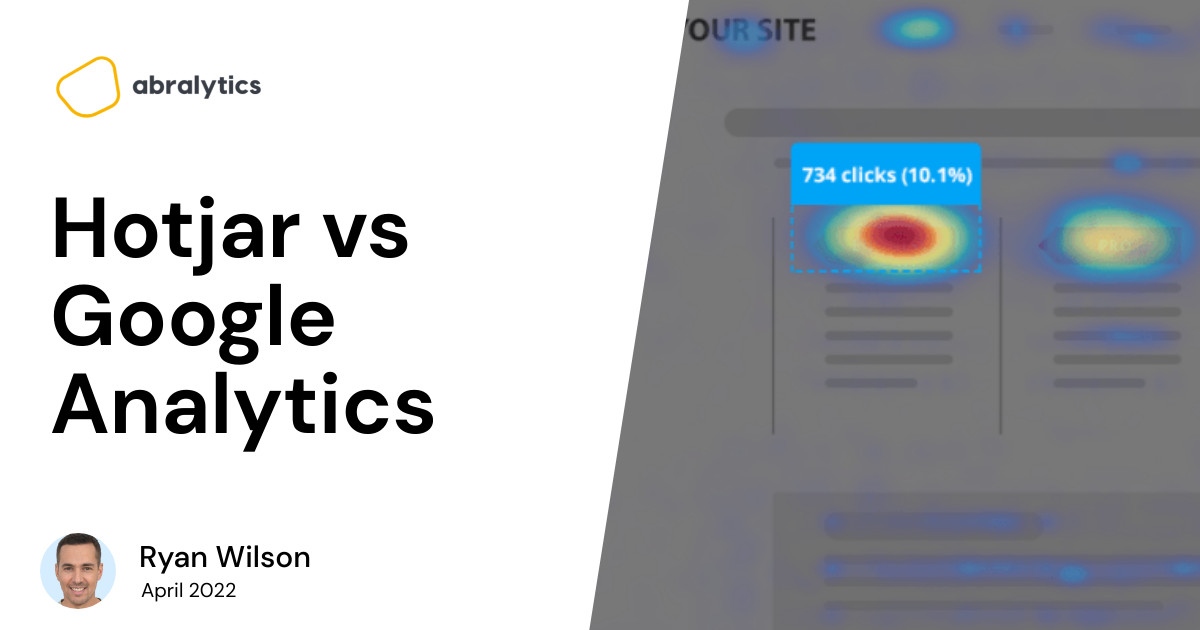Choosing an analytics software for your marketing efforts can be an uphill battle, let’s be honest.
You might be stuck between choosing a tool that will give you either:
- Heat maps or Analytics
- Video recordings or path exploration, etc
Or you might simply want to know which tool has more powerful analytics features.
So if you’ve filtered down to Hotjar vs Google Analytics, and you’re looking for a detailed comparison of these two tools, then read on.
In this article, we have covered the differences between these two analytics platforms; their pros and cons, pricing models, FAQs, alternatives and how to use both tools for better analysis.
Now, let’s get started by answering the most basic question; What are Hotjar and google analytics?
What Is Hotjar?
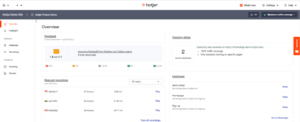
Source: Hotjar Dashboard
Hotjar is both a heat map service and analytics software that is used to track user behaviour on web pages.
The tool provides a visual report consolidated from heatmaps, session recordings, and user surveys so that you can make sense of how users behave on your web pages, perform A/B split testing, improve user experience and optimize your conversion funnels.
It’s easy to read the analysis of your web pages and discover your most effective marketing channels, the geolocation of your traffic, how they navigate your website, where they drop off, etc.
But there’s one problem…
You will be left to second-guess the “why” in all these analyses.
- Why do they drop off?
- Why did they scroll down the page?
- Why did they spend time on this part of this page?
- User feedback about how they feel about your page
Without features like heat map, recordings, direct feedback and survey, you can’t understand the “why” in the report.

Source: Hotjar Dashboard
Advantages Of Hotjar
Hotjar has competitive features that knock off Google Analytics.
While Google Analytics does analysis pretty well, Hotjar is packed with both analytical advantage and user behaviour intuitiveness.
Let’s break this down.
Heat Map For User Behavior
The unique Heatmap software takes the analytics bar so high that it can show you:
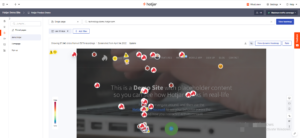
Source: Hotjar Dashboard
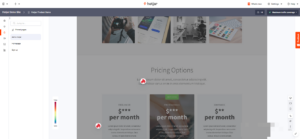
Source: Hotjar Dashboard
- The elements on your website layout that users interact with the most.
- Parts of your website that your visitors completely ignore.
- Pre/post changes on your website so that you can see where users click the most.
- Comparison between mobile and desktop devices.
Features that are absent on Google Analytics
Visitor Recordings

Source: Hotjar Dashboard
Visitor recording is playback recordings of your visitors’ scrolling, u-turning, rage clicking on any landing page, from the entry point to exit.
Again, this is another competitive feature that puts Hotjar ahead of Google Analytics.
You can use visitor recordings to:
- Discover if certain pages take time to load.
- Learn conversion patterns of your web visitors.
- Find out how they navigate your page.
Collect Instant Feedback From Users
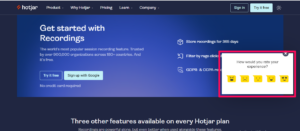
Source: Hotjar Website
You can discover how a user feels about a certain page, features or your services in general.
The data you collect at this point has high authenticity because users react to how they feel at the moment as opposed to asking for feedback when emotions might have been watered down.
Disadvantages Of Hotjar
While there are top-tier features that Hotjar leverages to drive user acquisition, there are obvious drawbacks that turn Digital Marketers off from the software.
Pricing
Just like Google Analytics, Hotjar has a paid version and a free version, however, Google Analytics’ free version provides more than enough insights that are required to scale any marketing strategy.
Complex User Interface
Hotjar shares a similar user interface with Google Analytics and this is challenging for users without any analytics background or users who are putting their foot forward into analytics for the first time.
This is unlike Abralytics, an alternative to Google Analytics and Hotjar, you can track and read all metrics and reports from your dashboard, and discover optimization opportunities without any prior background in web analytics.
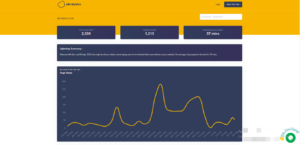
Source: Abralytics Dashboard
What’s more, all the basic data that you need to make the most effective decisions are reported in simple terms, right from the dashboard.
Hotjar Pricing
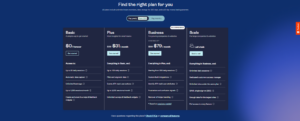
Source: Hotjar Pricing Page
Just like Google Analytics, Hotjar has a free and paid version.
However, Google Analytics’ free version will give you more analyses of your website, with depth insights and optimization opportunities.
According to Enlyft, there are only 14,694 companies that use Google Analytics 360 when compared to its free version.
This tells how much benefit the free version is to millions of other companies that use Google Analytics.
For Hotjar, you only get 35 sessions per day on their Basic plan which costs 0$.
A session according to Hotjar equals a visitor’s full journey across every page.
Additionally, you will get automatic data capture, an unlimited number of heat maps, and 1,050 sessions per month.
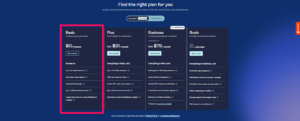
Source: Hotjar Pricing Page
What Is Google Analytics?

Source: Google Analytics Dashboard
Google Analytics is a website analytic tool from Google that is used to analyze traffic on web pages, track marketing ROI, and identify gaps in the quality of website visitors from different referrers to determine how to optimize any conversion funnel.
Advantages Of Google Analytics
Here are the main advantages of Google Analytics that puts it ahead of other core analytics tools.
Google Analytics Vs. Google Analytics 360
One of the main advantages of Google Analytics in the pool of other tools is the amount of data that can be analyzed using its free version.
What’s more noteworthy is that the FREE version can be used for life, and if your business is relatively small, you have no reason to upgrade to Google Analytics 360.
Wide Range Of Active Users
If you’re going to choose a tool for your marketing goals, you should look out for tools with a large number of users.
This can come as an advantage if you’re a marketer who relies on getting help from users in mutual communities, so the more pro-users you can get help from, the easier it is to learn from others and navigate the tool.
Integration With Other Marketing Tools
When deciding over analytics tools to choose from, think long-term and choose software that allows mutual integration with a host of other marketing tools, this is one of the core advantages of Google Analytics.
Currently, Google Analytics allows integration with major marketing platforms like WordPress, GetResponse, SalesForce Pardot, Iterable, Aweber, SendinBlue, etc.
Disadvantages Of Google Analytics
While Google Analytics might shine brighter than other core analytics software, there are obvious limitations that you should worry about if your choice over other tools is Google Analytics.
Complexity Of The Interface
To use Google Analytics and navigate the dashboards with ease, you must have advanced knowledge in analytics and have months of user experience with the tool, this is discouraging especially to new users who have no prior knowledge in analytics or users who prefer easy-to-read analytics data.
Issue With Privacy
If privacy is one of your major business concerns, then Google Analytics is not the tool for you.
As a matter of fact, Google is able to keep its analytics tool free because they use the data you generate from your website to serve ads to its users.
How Much Is Google Analytics?
Google Analytics is a perfect example of a FREEMIUM tool.
You can track endless goals with the free version of the Google analytics tool completely free of charge.
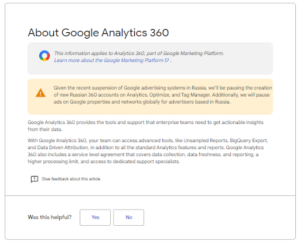
Source: Google Analytics 360 Page
Though if you’re a bigger organization that generates 1 Billion + hits, then you can switch to Google Analytics 360 for $150,000 per year.
How To Use Google Analytics And Hotjar Together
According to Hotjar, their Analytics software isn’t supposed to be a Google Analytics replacement but a compliment to the other.
These two tools have unique tacking features and unique goals they achieve, and when used side-by-side, you can fill the gaps where the other lapses.
Here are the different times you should use Google Analytics and Hotjar together.
When Discovering How Users Behave
With Google Analytics you can:
- Discover the marketing channel that drives the best traffic.
- Find out the page visits that have the most conversion rates.
- Note the pages with low conversion.
Once you have these data points, you can use Hotjar to:
- Watch session recordings of the pages with high and low conversion
- Gain a better understanding of what makes your visitors convert or drop off.
Before And After Tweaking Your Website Layout
Use Google Analytics to monitor, compare and record performance after any change on your website.
With Hotjar:
Before making the changes, you can use Hotjar to understand how your visitors interact with your page and identify what to change or what to improve on.
You can also collect feedback from your users regarding their experience using your page.
Interestingly, the results you get from using both analytics tools are endless, and if you arm yourself or your marketing team with insights this great, you should be able to see conversion shoot up.
FAQs About Google Analytics Vs Hotjar
Here are frequently asked questions that you might have about Google Analytics and Hotjar.
How is Hotjar different from Google Analytics?
Hotjar is both a heat map software and an analytics tool for measuring traffic and user behaviour on web pages and identifying optimization opportunities.
On the other hand, Google Analytics is a full-blown analytics tool from Google whose popularity and the wide number of users indicate its popularity.
Is Hotjar better than Google Analytics?
Hotjar has advanced features that look beyond just analytics, this includes feedback services, heat map tools, scroll map, visitor recordings, click map, etc.
Though in marketing, no analytics software is more powerful than the other, this is because marketing goals and KPIs differ by organization.
While you might care to know the more powerful tool between the two, the best strategy for getting better insight is to combine their best features and collect data and reports that will benefit your conversion funnel.
Ironically, Hotjar uses Google tag manager as a recommended method for sending events to Hotjar.
Can Hotjar replace Google Analytics?
Hotjar might not be a direct Google Analytics replacement because they serve different user types, and they are used to collect data for different purposes.
Instead of total replacement, Digital Marketers will take advantage of their differences to read a wide range of reports that each of the tools can’t provide in isolation.
Conclusion
Making a choice from the so many available analytics tools might become a hassle if you don’t understand the metrics you should be tracking in the first place.
Your choice should largely be influenced by the type of results you’re looking for.
- Are you tracking the marketing funnel that drives the best quality lead?
- Are you comparing conversions between multiple web pages?
- What visitors’ behaviour are you interested to discover?
- Do you want a closer look at rage clicks and mouse movements on your site?
- Are you looking for suggestions from real users who interact with your pages?
These are the kind of questions that should influence the decision your organization takes.
While both analytics tools are great options for any business type, their dashboards might be challenging for non-techie business owners who are looking for simple analytics tools.
What’s worse, you will need months and years of experience in web analytics before you can navigate and makes sense of the reports collected from these tools.
So if you’re looking for an analytics tool that can give you a forthright analysis of your data in simple understandable terms, then check out Abralytics and start analyzing your data in seconds.

